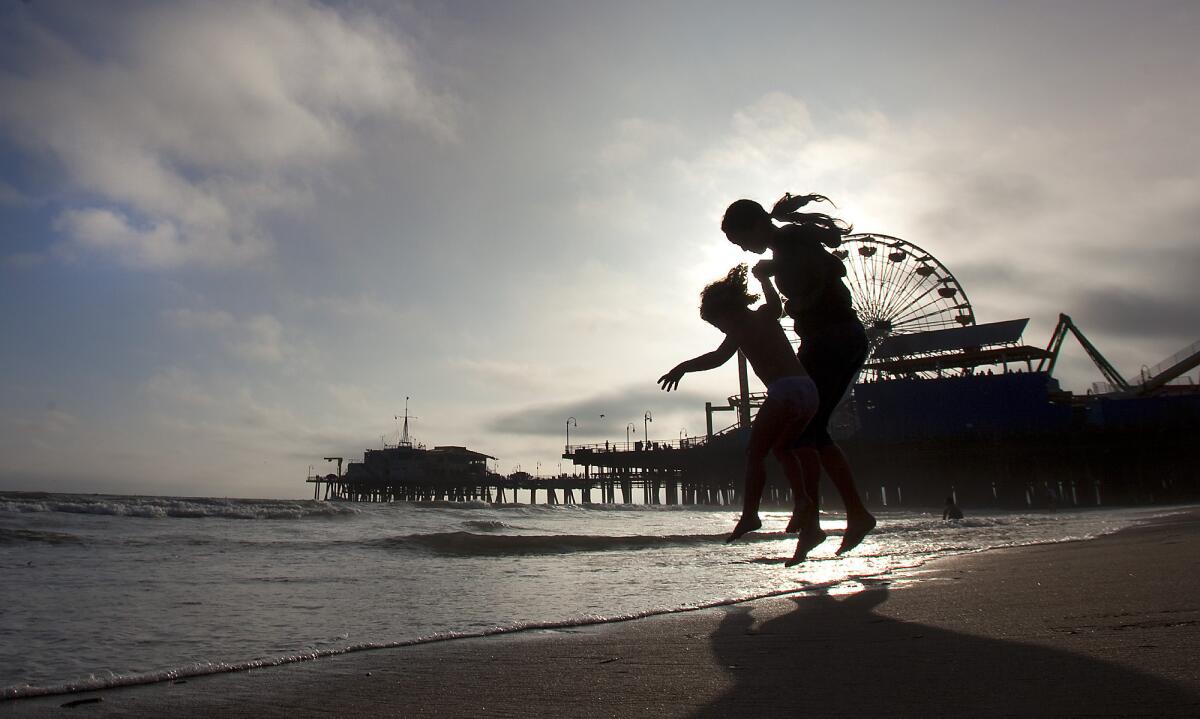Drought’s upside? Better water quality at beaches, report says

- Share via
There’s at least one upside to the drought: Record-low rainfall has resulted in cleaner water up and down the California coast, a new report says.
Ninety-five percent of California beaches earned A or B grades for water quality during the summer of 2013, a 2% improvement over the previous year, according to the annual Beach Report Card released Thursday by Heal the Bay, an environmental group.
The grades ticked up largely because lower amounts of polluted runoff flowed down to the coast during the driest year on record, Heal the Bay says.
The analysis uses water-quality test results from hundreds of beaches to assign each a grade of A to F based on the level of bacteria in beach water, which can indicate pathogens that can sicken swimmers.
The report found improvements even at Los Angeles County beaches, which have long been among the most polluted in the state. Last year 90% of the county’s beaches earned A or B grades, compared with 84% during the previous year’s summer season, which runs from April to October.
The higher grades may seem like encouraging news for beachgoers. However, 2013 was the driest calendar year in 119 years of record-keeping and the runoff-diminishing effect of several years of low rainfall “may be providing a false sense of long-term beach water quality improvement,” the report says.
Water quality could turn for the worse if, as predicted, an El Niño develops in the Pacific Ocean later this year, potentially bringing more precipitation to sweep a greater volume of contaminated runoff to California beaches.
Three L.A. County beaches made the report’s statewide list of the Top 10 worst-polluted “Beach Bummers:” Mother’s Beach in Marina del Rey, Cabrillo Beach in San Pedro and the popular beach at the Santa Monica Pier, which rejoined the list at No. 7 after four years of cleaner test results.
City of Santa Monica officials blamed the dip in water quality on large rips in netting they had installed under the pier to keep pigeons from gathering and polluting the water with bacteria-laden droppings.
“We don’t have any sewage leaks or storm drain runoff during dry weather in the summer,” said Dean Kubani, sustainability manager for the city.
Santa Monica has since repaired the netting and expects to see water quality readings jump back up again next year, he said, adding that “if we don’t see improvement, we’re going to take every action that we need to ensure that the water’s clean.”
The No. 1 worst-polluted beach in California last year, according to Heal the Bay, was Cowell Beach near the wharf in Santa Cruz.
Water quality continued to improve in Long Beach, which was once notorious for its polluted shoreline. The city’s beaches earned 87% A and B grades during the summer, up 10% from the previous year.
Also significantly cleaner was the main beach at the Santa Catalina Island tourist hub of Avalon, which had ranked among the 10 most-polluted beaches for 12 of the last 14 years because of chronic leaks in its sewer system.
Water regulators in 2011 ordered the small city to address the problem by fixing its sewers, improving monitoring and correcting other problems. The city has since spent millions on repairs and adopted ordinances and pollution-reduction measures that have cleaned up bacteria levels enough to remove it from the “Beach Bummer” list.
Poche Beach, another long-polluted beach in San Clemente, also disappeared from the list of 10 dirtiest beaches.
City officials credited a falconer they hired last year to scare away seagulls polluting the water with their droppings, as well as coyote decoys deployed by the county and an ultraviolet treatment plant running that disinfects storm water before it spills into the ocean.
“It seemed to have an immediate effect,” city of San Clemente Environmental Analyst Mary Vondrak said of the falconer. “When he started working at the beach we had the gulls cleared out within a week and we started having A grades.”
Other popular beaches improved just enough to be removed from the list of worst-polluted beaches, but still have a long way to go before they can be considered clean.
“Malibu Pier and Redondo Pier may have missed this year’s Beach Bummer list,” the report says. “However, it is concerning that both locations earned C grades ... during one of the driest years on record.”
For some of the cleanest beaches around, Heal the Bay recommends an “honor roll” of 33 beaches statewide that earned A-plus grades for excellent year-round water quality. Among them are The Wedge in Newport Beach, Main Beach in Laguna Beach, Will Rogers State Beach at Pulga Canyon and several beaches in Carlsbad.
The leading cause of water pollution at beaches is urban runoff, which as a result of rain or irrigation sweeps a stew of contaminants from lawns, roadways and industrial sites through the region’s creeks, storm drain system and rivers and to the coast.
To address the problem, Heal the Bay recommends local governments adopt new fees and ordinances to build rain- and runoff-capturing infrastructure to prevent contaminated water from reaching the shore.
Here is a list from Heal the Bay of beach monitoring sites with the worst water quality in the April-to-October period last year:
Beach Bummers
1. Cowell Beach at Wharf (Santa Cruz County)
2. Marina Lagoon (San Mateo County)
3. Marina del Rey Mother’s Beach (Los Angeles County)
4. Cabrillo Beach harbor side (Los Angeles County)
5. Stillwater Cove (Monterey County)
6. Clam Beach County Park (Humboldt County)
7. Santa Monica Pier (Los Angeles County)
8. Pillar Point Harbor (San Mateo County)
9. Capitola Beach west of jetty (Santa Cruz County)
10. Windsurfer Circle (San Francisco County)
More to Read
Sign up for Essential California
The most important California stories and recommendations in your inbox every morning.
You may occasionally receive promotional content from the Los Angeles Times.














